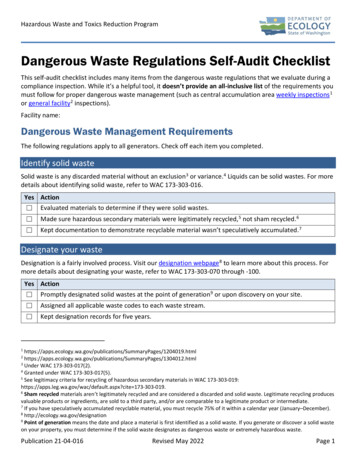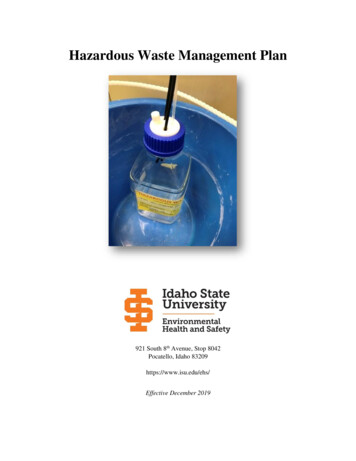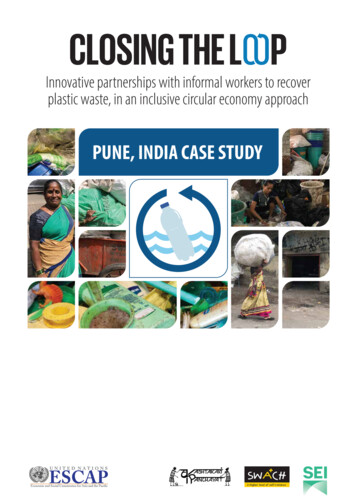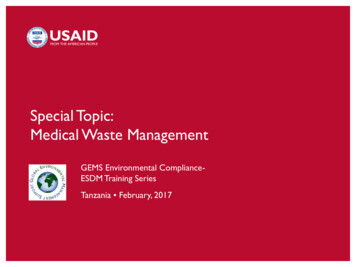
Transcription
Hazardous Waste and Toxics Reduction ProgramDangerous Waste Regulations Self-Audit ChecklistThis self-audit checklist includes many items from the dangerous waste regulations that we evaluate during acompliance inspection. While it’s a helpful tool, it doesn’t provide an all-inclusive list of the requirements youmust follow for proper dangerous waste management (such as central accumulation area weekly inspections1or general facility2 inspections).Facility name:Dangerous Waste Management RequirementsThe following regulations apply to all generators. Check off each item you completed.Identify solid wasteSolid waste is any discarded material without an exclusion 3 or variance.4 Liquids can be solid wastes. For moredetails about identifying solid waste, refer to WAC 173-303-016.Yes Action Evaluated materials to determine if they were solid wastes. Made sure hazardous secondary materials were legitimately recycled, 5 not sham recycled. 6 Kept documentation to demonstrate recyclable material wasn’t speculatively accumulated.7Designate your wasteDesignation is a fairly involved process. Visit our designation webpage 8 to learn more about this process. Formore details about designating your waste, refer to WAC 173-303-070 through -100.Yes Action Promptly designated solid wastes at the point of generation 9 or upon discovery on your site. Assigned all applicable waste codes to each waste stream. Kept designation records for five publications/SummaryPages/1304012.html3Under WAC 173-303-017(2).4Granted under WAC 173-303-017(5).5See legitimacy criteria for recycling of hazardous secondary materials in WAC px?cite 173-303-019.6Sham recycled materials aren’t legitimately recycled and are considered a discarded and solid waste. Legitimate recycling producesvaluable products or ingredients, are sold to a third party, and/or are comparable to a legitimate product or intermediate.7If you have speculatively accumulated recyclable material, you must recycle 75% of it within a calendar year ation9Point of generation means the date and place a material is first identified as a solid waste. If you generate or discover a solid wasteon your property, you must determine if the solid waste designates as dangerous waste or extremely hazardous waste.12Publication 21-04-016Revised May 2022Page 1
Determine your generator categoryYour generator category is based on the amount of dangerous waste you generate each month. It may changeeach month. For more details about generator categories, refer to WAC 173-303-169 or visit our generatorcategory webpage. 10YourGenerator Category CriteriaCategory Small quantity generator (SQG)—generated less than or equal to the following amounts in acalendar month: Less than or equal to 220 pounds of dangerous waste that isn’t acute hazardous waste(AHW) and/or toxic extremely hazardous waste (EHW). Less than or equal to 2.2 pounds of AHW and/or toxic EHW. Less than or equal to 220 pounds of any residue or contaminated soil, water, or otherdebris resulting from the cleanup of a spill, into or on any land or water, of any AHWand/or toxic EHW.Medium quantity generator (MQG)—generated any of the following amounts in a calendarmonth: Greater than 220 pounds but less than 2,200 pounds of dangerous waste that is not AHWand/or toxic EHW. Less than or equal to 2.2 pounds of AHW and/or toxic EHW. Less than or equal to 220 pounds of any residue or contaminated soil, water, or otherdebris resulting from the cleanup of a spill, into or on any land or water, of any AHWand/or toxic EHW.Large quantity generator (LQG)—generated any of the following amounts in a calendar month: Greater than or equal to 2,200 pounds of dangerous waste that is not AHW and/or toxicEHW. Greater than 2.2 pounds of AHW and/or toxic EHW. Greater than 220 pounds of any residue or contaminated soil, water, or other debrisresulting from the cleanup of a spill, into or on any land or water, of any AHW and/ortoxic EHW.Follow treatment by generator requirementsCommon methods for treating your waste on site include elementary neutralization, solidification,evaporation, filtration, carbon adsorption, separation, polymerization, and aldehyde deactivation. For moredetails about treatment by generator requirements for MQGs and LQGs, refer to WAC 173-303-170(2)(b)(iv).Yes Action10 Used a treatment log to record the dates and amounts of waste treated on site. Kept treatment log for five cation 21-04-016Revised May 2022Page 2
Yes Action Met the general performance standards11 (i.e., treated wastes in a way that didn’t present a risk tohuman health and the environment). Didn’t treat dangerous waste on drip pads. Contacted Ecology prior to using a different treatment method.Respond to spills and discharges into the environmentFor more details about spills and discharges into the environment, refer to WAC 173-303-145.Yes Action Immediately reported dangerous waste or hazardous material spills to the environment to Ecology.See our Focus on: Reporting Dangerous Waste Spills 12 publication. Controlled or mitigated dangerous waste or hazardous material spills or discharges.Protect stormwater and industrial wastewaterYes Action Didn’t discharge any polluting matters13 to waters of the state. 14 Met all requirements for the pretreatment of dangerous wastewater 15 if you use the permit by ruleexclusion. See our Focus on: Treating Dangerous Waste Under Permit by Rule 16 publication.Properly manage specific types of wasteUsed oilFor more details about used oil, refer to WAC 173-303-515 or our used oil webpage. 17Yes Action Stored used oil in containers or tanks labeled with the words “Used Oil.” Immediately cleaned up used oil spills or leaks. Didn’t mix used oil with dangerous wastes (such as chlorinated solvents, antifreeze, etc.). Kept used oil in closed containers, except when adding or removing used oil. Managed used oil in accordance with all used oil requirements in WAC 173-303-515.Performance standards: WAC 173-303-283(3)(a) – ryPages/2004036.html13Polluting matter includes waste that may not be a dangerous waste or hazardous substance, such as wastewaters from efault.aspx?cite 90.48.08015WAC wa.gov/UsedOil1112Publication 21-04-016Revised May 2022Page 3
Recycled spent antifreezeFor more details about recycled spent antifreeze, refer to WAC 173-303-522 or our spent antifreezewebpage. 18Yes Action Made sure spent antifreeze that’s managed under the rule is ethylene glycol–based. Kept spent antifreeze separated from other dangerous wastes. Stored spent antifreeze in containers labeled with the words “Spent Antifreeze.” Reclaimed and recycled spent antifreeze. Kept spent antifreeze records 19 for five years. Managed spent antifreeze in a way that prevented releases to the environment during accumulation(e.g., keeping containers closed and using secondary containment).Universal wasteThese requirements apply to handlers of universal waste. 20 For more details about universal waste, refer toWAC 173-303-573 or the universal waste webpage. 21Yes Action Managed universal wastes in a way that prevented releases to the environment (e.g., kept containersclosed). Labeled universal waste containers as one of the following: Universal Waste—Batteries Waste Batteries Used Batteries Universal Waste—Lamps Waste Lamps Used Lamps Accumulated universal wastes one year or less. Demonstrated universal waste storage time by dating containers, keeping recycling receipts, recordingdates in a log book, etc. 22https://ecology.wa.gov/AntifreezeProof of reclamation/recycling is either a log for on-site reclamation/recycling or an invoice or bill of lading for off-sitereclamation/recycling20A small quantity handler of universal waste accumulates less than 11,000 pounds total of universal waste (batteries, mercurycontaining equipment, and lamps, counted collectively) and/or does not accumulate more than 2,200 pounds of lamps at any time.See the definition of and requirements for large quantity handlers of universal waste in subsections WAC 173-303-040 and WAC173-303-573(17) through ly a start date on container, use an inventory system, or any other method that demonstrates length of accumulation time.1819Publication 21-04-016Revised May 2022Page 4
Dangerous Waste Management Requirements by GeneratorCategoryAll generators must meet requirements based on their generator category. Refer to WAC 173-303-170 formore details. Find the sections that apply to your generator category and check off each item you completed.SQG requirementsSee WAC 173-303-170(2)(a)(i) for more details about SQG independent requirements. You may also need tokeep records of certain activities. Refer to the recordkeeping requirements section for more information.Independent requirements for SQGsYes Action Dangerous waste management didn’t pose a potential threat to human health or the environment. Submitted a Dangerous Waste Annual Report by March 1st for the previous calendar year if you havean active EPA/State ID Number.Conditions for exemption: SQGsYou may store dangerous waste on site without obtaining a treatment, storage and disposal (TSD) facilitypermit 23 if you meet SQG conditions for exemption. 24 For more details about exemption conditions, refer toWAC 173-303-170(2)(b)(i).Yes Action Made sure total accumulation amounts at one time didn’t exceed: 2,200 pounds of dangerous waste. 2.2 pounds of AHW or toxic EHW. 220 pounds of any residue or contaminated soil, water, or other debris resulting from thecleanup of a spill, into or on any land or water, of any AHW and/or toxic EHW.Did one of the following with your accumulated dangerous waste: 25 Treated or disposed of it in a permitted and authorized on-site facility. Sent it to a permitted and authorized off-site facility. Met all requirements if managing dangerous waste under the alternative standards for episodicevents.26 If sent to an LQG under the control of the same operator: Labeled all containers and tanks with the words “Dangerous Waste” or “Hazardous Waste.” Marked all containers with the hazard(s) of the contents.As specified by WAC 173-303-600.Conditions for exemption for an SQG: WAC 173-303-171.25Both options are listed in WAC fault.aspx?cite 173-303-1732324Publication 21-04-016Revised May 2022Page 5
MQG and LQG requirementsSee WAC 173-303-170(2)(a)(ii) and (iii) for more details about MQG and LQG independent requirements.Independent requirements for MQGs and LQGsMQGLQGAction Obtained an active EPA/State ID Number for your site. Submitted a Dangerous Waste Annual Report 27 by March 1. Met applicable land disposal restrictions for dangerous wastes. Kept land restriction records for three years. Documented all dangerous waste shipments using Uniform Hazardous Waste Manifests. Kept designated facility-signed manifests for five years. Properly prepared all dangerous wastes for transport.Conditions for exemption: MQGs and LQGsYou may store dangerous waste on site without obtaining a TSD facility permit 28 if you meet MQG and LQGconditions for exemption. 29 We noted some actions that are required for MQGs only or LQGs only. 30 For moredetails about exemption conditions, refer to WAC 173-303-170(2)(b).Dangerous waste managementMQG LQG Action Sent dangerous waste to a permitted TSD or a facility authorized to receive dangerous wastefor disposal.N/A Accumulated dangerous waste on site for 90 days or less. N/A Accumulated dangerous waste on site for 180 days or less. N/A Made sure total accumulation amounts at one time didn’t exceed: 6,600 pounds of dangerous waste. 2.2 pounds of AHW or toxic EHW. 220 pounds of any residue or contaminated soil, water, or other debris resulting fromthe cleanup of a spill, into or on any land or water, of any AHW and/or toxic EHW.N/A Met all requirements if managing dangerous waste under the alternative standards forepisodic events. 31You must revise your Site ID Form if your company name, mailing address, ownership, physical location, or type of dangerouswaste activity changes anytime during the year.28As specified by WAC 173-303-600.29Conditions for exemption for MQGs and LQGs that accumulate dangerous waste: WAC 173-303-172, -174, -200, and -20130N/A means these actions are not applicable or x?cite 173-303-17327Publication 21-04-016Revised May 2022Page 6
MQG LQG ActionN/A Followed all applicable closure requirements32 if you closed the facility or a centralaccumulation area. This includes notifying Ecology 33 using the Site ID Form.N/A Met all notification, recordkeeping, reporting, labeling, and disposal requirements if youreceived dangerous waste from SQGs under the control of the same operator. See our focussheet about LQG consolidation of SQG dangerous waste. 34Dangerous waste containersYour dangerous waste containers were:MQG LQG Action In good condition (no severe corroding, rusting, flaking, scaling, and/or apparent structuraldefects). Made of or lined with materials that will not react with, and are otherwise compatible with,the dangerous waste contents. Kept closed, except when adding or removing waste. Not opened, handled, or stored in a manner that may cause them to rupture or leak. Given at least 30 inches of aisle space between rows. 35 Placed in a secondary containment system, in accordance with requirement for liquids.36 Stored according to International Fire Code if they are ignitable or reactive. Separated by compatibility and accumulated in separate secondary containment. Clearly marked with the accumulation start date if in a central accumulation area. Marked or labeled with the words "Dangerous Waste" or "Hazardous Waste." The words “Dangerous Waste” or “Hazardous Waste” must be legible from a distanceof 25 feet or with lettering at least ½ inch tall. For containers one gallon (four liters) and under, the marking or lettering can beappropriate for the size of the container.Marked or labeled with an indication of the hazards of the contents (i.e., ignitable, corrosive,reactive, or toxic). Include descriptive words and/or pictograms that identify the hazards associated withthe container’s contents. Make the hazard label legible or recognizable from a distance of 25 feet or withlettering at least ½ inch tall. For containers one gallon (four liters) and under, the marking or lettering can beappropriate for the size of the container.WAC ryPages/2004016.html35A row of containers must be no more than two wide and allow for unobstructed inspection of each container.36WAC 173-303-630(7)3233Publication 21-04-016Revised May 2022Page 7
MQG LQG Action N/AN/A Met the tank standards37 if accumulating dangerous waste. This includes—but is not limitedto—secondary containment, labeling, compatibility, and daily and weekly tank inspections. Met the tank standards38 if accumulating dangerous waste in tanks. This includes—but is notlimited to—applicable air emissions standards, written tank assessment, secondarycontainment, labeling, compatibility, and daily tank inspections.39Satellite accumulation areasMQG LQG Action Your satellite accumulation areas were below all of the following amounts: 55 gallons of dangerous waste. 1 quart of liquid AHW or 2.2 pounds of solid AHW. Once you reached any of the above amounts, you immediately applied a start date andmoved the container(s) to your central accumulation area within 3 days. Your satellite accumulation areas were at or near the point of generation (where you initiallygenerated the waste). Your satellite accumulation areas were controlled by the operator that generates the waste orsecure at all times.InspectionsMQG LQG Action Developed a written general facility schedule for inspecting all monitoring equipment, safetyand emergency equipment, security devices, and operating and structural equipment at thesite. Conducted and documented weekly inspections of each central accumulation area. Conducted and documented site-wide general facility inspections. Conducted and documented annual inspections 40 of ignitable or reactive waste areas ifstoring those types of waste. Kept a written or electronic log41 at the facility for at least 5 years after the dates ofinspections.Emergency preparednessMQGLQGAction Made sure the facility was designed and constructed to minimize the possibility of fire,explosion, or any unplanned sudden or non-sudden release of dangerous waste ordangerous waste constituents.WAC 173-303-172(6)WAC ations/SummaryPages/2004031.html40WAC 173-303-395(1)(d)41The log must include date and time of inspection, printed name, and signature/electronic signature of the inspector, observationsmade, and date and nature of repairs or remedial actions.3738Publication 21-04-016Revised May 2022Page 8
MQGLQGAction Maintained and operated the facility to minimize the possibility of fire, explosion, or anyunplanned sudden or non-sudden release of dangerous waste or dangerous wasteconstituents. Provided and maintained emergency equipment in all areas where you generated andaccumulated dangerous waste. Made sure personnel had immediate access to communication devices and/or alarmswhile handling dangerous waste. Maintained unobstructed aisle space so personal and emergency equipment can move toany area of the facility in an emergency. Made and documented necessary arrangements with local emergency responseauthorities. Assigned a designated emergency coordinator that was on the premises or on call at alltimes. Met generator closure requirements if you closed a central accumulation area. N/APosted dangerous waste emergency information 42 next to all emergency communicationdevices (e.g., telephones, two-way radios, etc.) or in each area directly involved indangerous waste generation and accumulation.N/A Prepared a written contingency plan 43 and quick reference guide. They are available uponrequest.N/A Kept copies of the contingency plan and quick reference guide at your facility.N/A Submitted the contingency plan and quick reference guide to local emergency responders.N/A Amended the contingency plan and quick reference guide when necessary.N/A Submitted a report 44 to your Ecology regional office within 15 days if you had toimplement the contingency plan.Personnel trainingMQGLQGAction N/AMade sure employees were familiar with proper waste handling and emergencyprocedures relevant to their positions.N/A Developed and maintained a training program that teaches personnel to perform duties incompliance with the Dangerous Waste Regulations. See our Guide to Dangerous WasteTraining. 45N/A Made sure dangerous waste curriculum covers dangerous waste managementprocedures46 relevant to employees’ positions and ensures facility personnel can respondeffectively to emergencies. This includes training on how to use the contingency plan.N/A Trained employees within six months of ublications/SummaryPages/2004029.html44WAC blications/SummaryPages/2004034.html46This includes contingency plan implementation.4243Publication 21-04-016Revised May 2022Page 9
MQGLQGActionN/A Made sure employees reviewed the training annually.N/A Documented personnel training records and have them available upon request.Recordkeeping RequirementsDepending on your generator category, you must keep records documenting certain activities. Many of themmust be retained for 5 years. Common records to keep include: Waste designation Notification of dangerous waste activities Dangerous waste annual reports Uniform hazardous waste manifests(UHWM) Bills of lading, or other shipping receipts Exception reports Land disposal restrictions documents Weekly inspection checklist Daily tank inspection logs Facility inspection reports, logs, andschedule Employee training plan and records Written contingency plan and quickreference guide Solvent-recycling (still) logs Treatment by generator log Current permit AND original permitapplication when treating waste in a permitby rule unit Spill reportsSee our keeping records webpage 47 for more ication 21-04-016Revised May 2022Page 10
Acronyms and AbbreviationsAHW: Acute hazardous wasteEHW: Extremely hazardous wasteEPA: U.S. Environmental Protection AgencyID: IdentificationLQG: Large quantity generatorMQG: Medium quantity generatorN/A: Actions are not applicable or requiredSQG: Small quantity generatorTSD: Treatment, storage and disposalUHWM: Uniform hazardous waste manifestsWAC: Washington Administrative CodeMore InformationContact your nearest Ecology regional office 48 if you have questions about dangerous waste managementpractices.Department of Ecology regional officesSouthwest regional office: 360-407-6300Counties: Clallam, Clark, Cowlitz, Grays Harbor, Jefferson, Mason, Lewis, Pacific, Pierce, Skamania,Thurston, WahkiakumNorthwest regional office: 206-594-0000Counties: Island, King, Kitsap, San Juan, Skagit, Snohomish, WhatcomCentral regional office: 509-575-2490Counties: Benton, Chelan, Douglas, Kittitas, Klickitat, Okanogan, YakimaEastern regional office: 509-329-3400Counties: Adams, Asotin, Columbia, Ferry, Franklin, Garfield, Grant, Lincoln, Pend Oreille, Spokane,Stevens, Walla Walla, Whitman48https://ecology.wa.gov/contactPublication 21-04-016Revised May 2022Page 11
Managed universal wastes in a way that prevented releases to the environment (e.g., kept containers closed). Labeled universal waste containers asone of the following : Universal Waste—Batteries Waste Batteries . Demonstrated universal waste storage time by dating containers, keeping recycling receipts, recording










